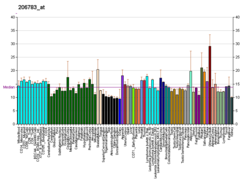Top Qs
Timeline
Chat
Perspective
FGF4
Fibroblast growth factor gene From Wikipedia, the free encyclopedia
Remove ads
Fibroblast growth factor 4 is a protein that in humans is encoded by the FGF4 gene.[5][6]
The protein encoded by this gene is a member of the fibroblast growth factor (FGF) family. FGF family members possess broad mitogenic and cell survival activities and are involved in a variety of biological processes including embryonic development, cell growth, morphogenesis, tissue repair, tumor growth and invasion. This gene was identified by its oncogenic transforming activity. This gene and FGF3, another oncogenic growth factor, are located closely on chromosome 11. Co-amplification of both genes was found in various kinds of human tumors. Studies on the mouse homolog suggested a function in bone morphogenesis and limb development through the sonic hedgehog (SHH) signaling pathway.[6]
Remove ads
Function
Summarize
Perspective
During embryonic development, the 21-kD protein FGF4 acts as a signaling molecule critical for cell survival, proliferation, and patterning. It facilitates the survival and growth of the inner cell mass during the postimplantation phase by functioning as an autocrine or paracrine ligand.[7][8] In the apical ectodermal ridge (AER), FGF4 plays a key role in initiating and sustaining limb bud outgrowth for both forelimbs and hindlimbs.[9] It also regulates limb digit number and programmed cell death in the interdigital mesenchyme.[10] Altered levels or regulation of FGF4 can lead to limb abnormalities such as postaxial polydactyly and cutaneous syndactyly, collectively known as polysyndactyly. In the absence of Fgf8, FGF4 is able to compensate by rescuing skeletal defects, indicating overlapping functions of FGF4 and FGF8 in limb skeleton patterning.[10] In zebrafish, FGF4 is required for establishing the correct left-right patterning of visceral organs such as the liver, pancreas, and heart. In this context, FGF4 functions independently of FGF8, highlighting their distinct roles in visceral organ development.[11]
Fgf signaling pathway has also been demonstrated to drive hindgut identity during gastrointestinal development, and the up regulation of the Fgf4 in pluripotent stem cell has been used to direct their differentiation for the generation of intestinal Organoids and tissues in vitro.[12]
Remove ads
Clinical significance
In canines, FGF4 retrogene insertions on chromosomes 12 and 18 have important clinical implications, particularly in relation to skeletal morphology and intervertebral disc disease (IVDD). These insertions are associated with disproportionate dwarfism characterized by shortened limbs and abnormal vertebral development.[13][14]
The FGF4 retrogene on chromosome 12 is particularly associated with chondrodystrophy, a condition marked by shortened long bones, premature degeneration of intervertebral discs, and increased susceptibility to IVDD. These dogs often develop clinical symptoms such as spinal pain, limb weakness, and in severe cases, paralysis.[13][14]
Meanwhile, the insertion on chromosome 18 contributes to a similar short-limbed phenotype but with variable impact on disc health. Recognition of these genetic variants has practical implications for veterinary care and breeding strategies, especially in predisposed breeds like Dachshunds, Corgis, and Basset Hounds.[13]
Remove ads
References
Further reading
Wikiwand - on
Seamless Wikipedia browsing. On steroids.
Remove ads






